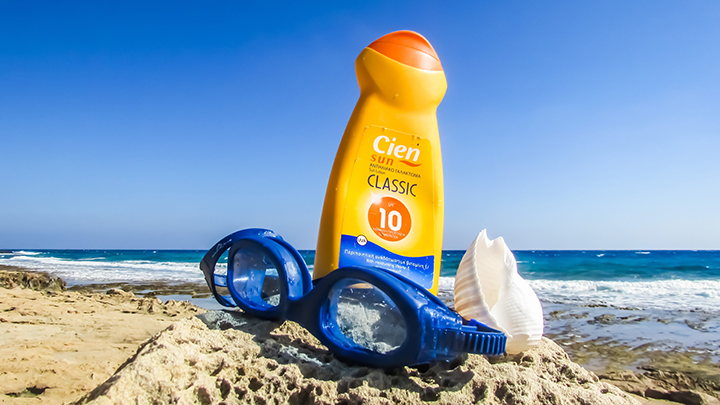Our skin is the largest and most complicated organ in our body; it plays a vital role in many essential tasks. It serves as the barrier protecting the inside of our body from the viruses and bacteria that are surrounding us. The importance of healthy skin runs deeper than the benefits of an attractive appearance; it is tied to our overall health and well-being. You probably have heard about the benefits of using a daily sunscreen. Sunscreen can prevent sunburn, premature aging, and even skin cancer when used regularly. Its primary purpose is to protect your skin from the sun’s damaging U.V. rays.
However, it’s likely uncommon knowledge that an online pharmacy petitioned the FDA to recall 40 batches of sun protection products in 2021. After routine testing, the company Valisure said that many popular brands, such as Banana Boat and Neutrogena, tested for high levels of the chemical benzene- a carcinogen. It’s said that some of the batches contained as much as three times the emergency FDA limit. Unfortunately, most companies making sun protection products aren’t transparent about the ingredients making up their products, nor the potential health risks that come with them. That’s why it’s our responsibility as consumers to educate ourselves on what to look for before making a big purchase.
There are two ways sunscreens can be made: with physical or chemical blockers. Sunscreens with chemical blockers are the more concerning of the two, as they contain chemicals that absorb the sun’s ultraviolet rays; one chemical blocker is called octinoxate. According to the Household Products Database from the U.S. Department of Health and Human Services, large companies like Olay, Aveeno, Revlon, Dove, etc., all use octinoxate in their products. L’Oreal has a page on its website supposedly debunking the claims of its unsafeness. Right now, there is insufficient evidence showing that octinoxate is more harmful than it is beneficial; therefore, there are not enough laws in place preventing its overuse. Here’s what you should consider when buying sunscreen, especially if it contains octinoxate:
Octinoxate is in products with SPF; that could be perfumes, hairsprays, aftershaves, moisturizers, lip balms, or makeup products. It can be recognized under various names: Octyl-methoxycinnamate, 2-ethylhexyl-4-methoxycinnamate, Avobenzone (Parsol, Escalol), or Neo Heliopan. While octinoxate is approved for use in all cosmetics worldwide, there is a limit to how much can be used at once. The maximum concentration in ready-to-use preparations varies according to local legislation; however, according to the U.S. FDA, the recommended use level is up to 7.5 percent.
Some users are more likely to be vulnerable to its side effects than others (i.e. babies and children, pregnant women, teenagers, and women of color). Studies have shown that octinoxate may affect women’s breast development, infant birth weight, or men’s sperm function. One of the most significant concerns of this chemical is its role in natural hormones. It is a hormone disruptor and can produce estrogen-like effects similar to oxybenzone. Lifetime estrogen exposure is a risk factor in the development and progression of breast cancer. Exposure to octinoxate has been found to significantly alter the reproductive systems of female offspring, with lowered hormone levels associated with infertility and miscarriages. It can also impact reproductive organs and development. Numerous studies have reported that octinoxate exhibits antiandrogenic activity, which is linked to disrupting reproductive organ development in males and females and can be further passed down to offspring. Octinoxate has also proven to be bad for the environment. The sale and distribution of sunscreens containing octinoxate are banned in Hawaii as of January 2021 to prevent coral reefs’ bleaching and increase the preservation of marine ecosystems. The same issue is now showing in Florida’s Key West and will likely result in the same ban.
These products are potentially harmful to human health with long-term use, as well as the health of the environment. It is up to the user to decide whether to risk buying a well-known brand out of convenience. The best advice to those concerned about ingredients like octinoxate is to do the proper research and read the labels before purchasing. Sunscreens should not be used to extend the duration of U.V. exposure (such as prolonged sunbathing). They should also not be used as a substitute for clothing on usually unexposed body parts.
There are, of course, alternative sunscreens that don’t use chemical blockers that are more beneficial. Some research suggests mineral sunscreens, particularly those containing iron oxides, offer much broader protection than chemical sunscreens. A few brands you might want to look into:
Coola Organic Sunscreen Lotion SPF50 Active Ingredients: Avobenzone, Homosalate, Octisalate, Octocrylene
Supergoop! Everyday SPF50 Sunscreen Active Ingredients: Homosalate, Octocrylene, Octisalate, Avobenzone
Kinfield Daily Dew SPF35 Active Ingredients: Zinc Oxide (20.0%)
Abigail Darling
My Indigo Sun researcher and writer




